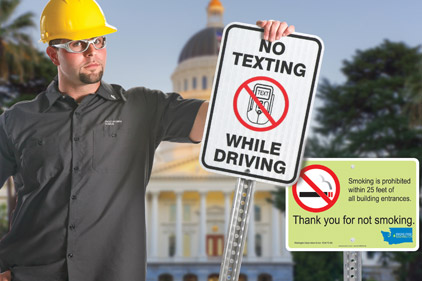Texting and cell phone bans
The Governors Highway Safety Association (GHSA) website summarizes the distracted driving laws for each state and provides a “Highway Safety Laws by State” map that allows visitors to select their state and view a summary of all applicable highway safety laws.
The Federal Communications Commission (FCC) website’s Distracted Driving Information Clearinghouse page lists firms and organizations committed to consumer education and outreach. Distraction.gov, a National Highway Traffic Safety Administration (NHTSA) site, offers a state-by-state summary of distracted driving laws. State department of transportation (DOT) websites are another valuable resource for distracted driving information.
No-smoking policies
Currently, no nationwide smoking regulations are in effect, and smoking restrictions vary based on state and local laws. Some states have comprehensive bans in private worksites, restaurants and bars, while others enforce partial bans in select venues — or no statewide restrictions at all.
On April 22, 2011, the Centers for Disease Control and Prevention (CDC) released a Morbidity and Mortality Weekly Report (MMWR) that summarized “State Smoke-Free Laws for Worksites, Restaurants, and Bars — United States, 2000-2010.” The report breaks down smoking laws by state, organizing them from comprehensive to nonexistent, and includes the effective date, if applicable. For the latest on state smoking regulations, visit the CDC’s State Tobacco Activities Tracking and Evaluation (STATE) System.
For more information on no-smoking laws, visit state health department websites. Another helpful resource is no-smoke.org, the website of the Americans for Nonsmokers’ Rights (ANR).
Concealed carry regulations
States also differ in terms of issuing concealed carry firearm permits to residents and non-residents. Their restrictions can be summarized in the below categories, from least to most restrictive:
- Unrestricted — The state does not require a permit to carry concealed.
- Shall issue — The state grants permits to individuals who meet standard requirements.
- May issue — The state may or may not issue a permit, even if the individual meets basic requirements. The issuing authority decides who receives a permit.
- No issue — The state denies the right to concealed carry.
State reciprocity is an important term for concealed carry permit holders to understand. It refers to the prerogative of each state to decide whether or not to honor another state’s concealed carry permits. The National Rifle Association’s Institute for Legislative Action (NRA-ILA) summarizes state constitutional provisions for gun laws on their website and provides additional information on reciprocity.
Even in concealed carry states, some locations — such as schools — are always off-limits. However, private businesses are responsible for determining their own policies.
When Wisconsin lifted its ban on concealed carry through the 2011 Wisconsin Act 35, the state department of justice (DOJ) made clear that businesses had a right to prohibit concealed carry on their property but had to provide notice to employees of any weapon restrictions. Employers were not allowed to restrict employees from keeping firearms in their vehicles.
To learn more, consult state DOJ websites.
No idling
The purpose of idling laws is to reduce emissions and conserve fuel without jeopardizing driver safety. Anti-idling laws also serve to protect public health and the environment.
Once again, there is no nationwide law, and as a result, no-idling regulations vary at state, county and local levels.
The Environmental Protection Agency (EPA) has published a “Compendium of Regulatory Language of U.S. Idle Ordinances and Laws,” including what a “model state” anti-idling law might look like as well as summarizing known state, county and local laws in effect. A quick search on the EPA’s homepage should bring up the document display in the results.
The EPA’s SmartWay® Technology Program focuses on finding ways to minimize freight transport pollutants and emissions. The SmartWay® webpage provides information on idling reduction technologies, strategies and best practices.
The American Transportation Research Institute (ATRI), a non-profit research organization for the trucking industry, publishes a free “Idling Regulations Compendium” that lists the regulations by state.
For more information or examples of approved no-idling signage, visit a state’s department of environmental protection website or equivalent services division.
